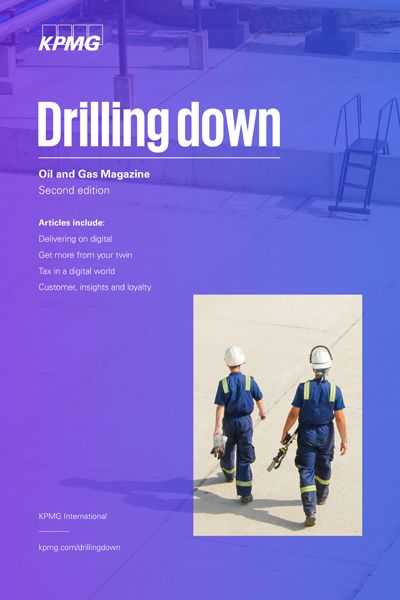The shift from hydrocarbons to electrons is underway. And many energy companies know they need to achieve a digital transformation to survive and thrive in the new energy environment. The challenges are significant. But so, too, are the opportunities.
From hydrocarbon to electron
Investors expect growth. Stakeholders are calling for transition. Customers want diversification. Employees are focused on purpose. And regulators are watching everything. One of the critical ways for energy companies to rise above these pressures and thrive is through digital transformation.
Don’t be fooled: digital transformation isn’t just about technology. It is also about doing things better, getting better insights, delivering better outcomes and building resilience for the future. It’s about knitting together the right capabilities, solutions, models and – yes – technology to deliver on your ambitions for the future. It’s about enabling your organization to act with agility as it evolves and building the foundations for growth. If you are starting with technology, you are looking at the problem from the wrong angle.
The key here is to consider what you want to be in the future and what digital capabilities your organization will require to get you there.
If you are contemplating growing your downstream and forecourt business, you will need key insights into your customers, their needs and expectations. If your plan includes diversifying into businesses in adjacent sectors – likely broadening your value chain from hydrocarbons to electrons – you will want to ensure you are making effective use of your data to help manage that complexity and drive those investment decisions. At the same time, your strategy probably involves doing what you do today (i.e., the upstream and midstream parts of the business) more efficiently and effectively, which requires enhanced operational awareness and control.
Now go beyond your business models to look at your broader ambitions. As the next chapter argues, digital transformation is a vital enabler of the energy transition and ESG agenda. If you are a purpose-led organization, your customers, employees and communities expect to see you take action on your promises, to back that action up with reliable data, and to report. Even the fundamental ambition of simply remaining ‘compliant’ with regulatory and tax requirements increasingly requires enhanced digital capabilities.
Our view suggests that digital transformation will be needed to execute all aspects of an energy company’s future strategies. And it will be critical to helping manage the risks and uncertainties of the future. Yet building these capabilities, solutions, models and technology ecosystems takes time and experience. You should think about them early, in an integrated fashion and with a clear vision of what you want to be and how you want to be perceived.
How can digital transformation help solve my big risks?
In late 2021, the Eurasia Group and KPMG articulated some big risks facing the world in 2022. Let’s look at a few and assess the value of digital.
Trade, market access and supply chain disruptions. A digital business can conduct meaningful scenario planning, adjust to changes in trade agreements, and enjoy a deeper insight into its supply chain so it can problem-solve early.
A rocky energy transformation. Digital energy companies see the risks and opportunities and can quickly pivot to accelerate progress or take advantage of new technologies and solutions.
Cybersecurity and governance chaos. An intelligent digital transformation roadmap puts cybersecurity and governance front and center. It provides organizations with the data they need to remain in control of their operations and data.
How digital delivers on sustainability
As energy companies look to meet their ambitious Net Zero goals, digital is increasingly seen as the lynchpin. Digital can be a key enabler of the energy transition; it can help drive and be a mechanism for transparency.
For example, consider how digital can help your organization reduce direct emissions. By digitally preparing for service and maintenance calls before dispatch, energy companies can reduce truck rolls and waste at the frontline. Digital can improve planning cycle times and remove process variances that often lead to routine flaring (a significant cause of emissions). Digital can help accelerate leak detection and mitigation, reduce upset conditions, and help manage energy consumption.
Or consider how digital can help drive indirect (or Scope 2) emissions. With the right data and insights, supply chains can be optimized. Waste can be removed from the process. And cleaner, greener suppliers and supply routes can be found. Digital can speed up the requisitioning process and ensure supplies are available at the right time, in the right place, and for the right people. And it can allow energy companies to better track their climate change efforts (and those of their suppliers and suppliers’ suppliers) down the value chain.
Digital can also have a massive impact on your Scope 3 emissions. Moving from in-house servers to the cloud doesn’t just move emissions from Scope 1 to Scope 3; it can also help eliminate them. Microsoft Azure™ cloud[1] is offering energy companies with a more sustainable set of products and technologies.
Indeed, there is a wide range of ways that data and digital can help drive the ESG agenda for energy. When Microsoft and KPMG firms work with clients, they often help them understand and quantify the climate impact of activities not usually considered within the traditional sustainability envelope.
KPMG firms and Microsoft show decision-makers how ERP modernization can allow them to integrate their data and improve their governance and reporting around climate impacts. The goal is to help them see the link between connected assets, operations, and data. They are shown how efficiency, skills enhancement, and collaboration can enhance the impact of their digital workforce on climate activity. The lines between ESG compliance, reporting, and data are clearly drawn.
Digital is the lynchpin to meeting your climate and Net Zero goals. It should be at the center of your strategy.
Where are the linkages?
Reduced planning cycle time, process variance and downtime = reduced routine flaring, improved site remediation and better managed energy consumption.
Enhanced demand intelligence, asset health and product design = a more balanced supply and demand, reduced upset conditions, and better product innovation.
Improved raw material handling, dispatch and route planning and asset integrity = faster leak detection, proactive leak mitigation and reduced emissions.
Optimized resource management, asset performance and stoppages = reduced process flaring, more rapid intervention and preventative measures.
Getting your arms around the data
If digital is the conduit, data is the liquid that flows through it. There is no use for digital without data. And the wrong data – or disconnected and unstructured data – can make a digital strategy ineffective. Simply put, at the center of every great digital strategy is great data.
But for the value of digital to be achieved and for use cases to be fully realized, data must be accessible, trustworthy and secure. It needs to flow to the right points, integrate with other data sources and deliver actionable insights. The problem is that most energy data currently in existence (and there is a lot of it) is locked up in siloes, stuck in the supply chain and purposefully separated between assets and systems.
This inability to harness operational and IT data hinders the company’s efforts to modernize its organizations, enhance its processes and improve supply chain collaboration. It reduces the returns energy companies can reap from their investments. It erodes decision-making confidence and creates multiple versions of ‘the truth’. It undermines growth.
A well-planned digital transformation starts with the data. And when Microsoft and KPMG firms work with clients in the energy sector, the focus is often on helping organizations achieve high-fidelity, real-time and trustable data and insights from their digital investments.
Cloud technology can play a crucial role here. Cloud solutions like Microsoft Azure can bring data from disparate systems together, provide the platform upon which it can be analyzed, deliver the processing capabilities and governance controls required, and do it all within tried and tested industry solutions. The cloud also allows organizations to see their data across complex systems – new and legacy.
If your organization is already migrating systems to the cloud (perhaps as part of an ERP modernization initiative), this is your opportunity to get your arms around your data. It’s also your opportunity to understand your data needs, assess your data quality and integrate new sources of data that can provide even deeper insights (such as sensors, supplier data or climate data).
The good news is that there are organizations – like Microsoft and KPMG – with deep experience helping similar organizations get their arms around their data. Indeed, the data challenge can quickly become a data opportunity with the right partners. The next chapter explains how.
It takes an ecosystem
You have an aggressive digital agenda. But do you have the right in-house skills, capabilities, people and talent to deliver? Digital transformation is a massive and complex project. And KPMG’s experience suggests that only one-in-three transformation projects deliver on their value expectations.
It requires a wide range of new skills and job profiles, including data scientists, software engineers, agile coaches, cybersecurity professionals and DevOps engineers. It involves energy companies stitching together a range of different systems and technologies – some new, some legacy. It takes smart change management and transformation skills to drive use and adoption. It also requires existing employees to upskill and learn new digital capabilities.
At the same time, no organization wants to reinvent the wheel – and nor should they. The world is filled with best practices, frameworks and solution sets that have been tried and tested in other organizations, situations and environments. The trick is to identify and apply the right ones for your organization.
The problem is that – in today’s tight human-capital environment – recruiting, developing and retaining experienced, skilled talent and capabilities is challenging. Energy companies compete against virtually every other company in the world for digital skills. Finding enough of the sort that meets your specific needs may not be easy.
PMG firms and Microsoft often work together at the cornerstone of these collaborations. In the energy sector, the KPMG and Microsoft alliance enables us to identify and integrate players with proven capabilities and solution sets and help ensure alignment, collaboration, and delivering the value of digital by working closely together.
No organization can likely navigate the scale of change required by digital transformation alone. Therefore, the real challenge facing energy companies is finding the right help with the right capabilities and skills to get you where you want to be.

Seeing the upside of cyber
One compromised password – that’s all it took to knock out 5,000 miles of gas pipeline.[2] Ransomware was installed. Critical business applications became unresponsive. The owner had no choice but to proactively shut down their operations. It’s a horror story no energy company wants to experience. And it’s a risk that no government or regulator wants to leave unmitigated.
The topic of energy infrastructure security is top of mind for politicians and policymakers around the world. From ransomware attacks to suspected nation-state hacks, regulators and governments are enacting a range of policies to ensure their critical infrastructure is resilient, safe and secure. The path to digitization must be a safe one.
Yet there is natural tension. On the one hand, energy companies should open up their data, integrate it across IT and OT, and make it accessible across the ecosystem. But on the other hand, they are ultimately responsible for keeping that data safe and secure. The tendency is to fall on the side of risk mitigation.
Energy leaders would be better served to see cyber as an opportunity as much as a risk. A robust and defensible cyber position gives the organization the confidence it needs to bring important data sets together. It allows the organization to be more agile, aggressive when entering new markets, and competitive when working with customers. A robust cyber stance isn’t just about protecting the organization from risks and fines; it’s about preparing the business to grow and thrive.
As such, energy companies should think carefully about how cyber is embedded into their digital transformation plans and operating models. They will want to select partners that can offer high levels of security. And they should consider how they can get ahead of cyber risks and requirements to ensure the value of the digital transformation is delivered.
Key takeaways
Energy companies should consider reinventing their business models with a sense of urgency
Digital transformation is required to deliver on the expectations of investors, employees and customers
Start by focusing on the big risks and opportunities – climate change, cyber, cloud migration and energy transition, for example.
Don’t underestimate the value and importance of reliable, high-fidelity, real-time data
Digital transformation is a massive undertaking, but there are best practices, solutions and partners that can help
KPMG and Microsoft
KPMG and Microsoft combine advanced technologies, industry insight, creative thinking, and established excellence in advising on complex global business issues to help transform your company in the areas most critical to your prosperity and ongoing sustainable success.
The strong portfolio of KPMG and Microsoft alliance offerings can help you address these challenges by building applications, automating manual processes, and continuously analyzing information to help reduce the risk of errors and increase your ability to make smart decisions. As you embark on your digital transformation journey, you can rely on KPMG professionals and our business-first approach to deliver effective Microsoft technology-based solutions to help you achieve meaningful and sustainable business outcomes.
Additional thinking
Get in touch
Stay connected
The email address you've entered is already tied to an existing account. Please enter your password to log in.
KPMG thought leadership is always available to our registered users
You’ve successfully logged in.
Please close this pop-up to return to the page.
Please provide the following information to register.

Follow us on LinkedIn
View regular energy content on our LinkedIn showcase page
Unless otherwise indicated, throughout this report, “we”, “KPMG”, “us” and “our” refer to the network of independent member firms operating under the KPMG name and affiliated with KPMG International or to one or more of these firms or to KPMG International.













